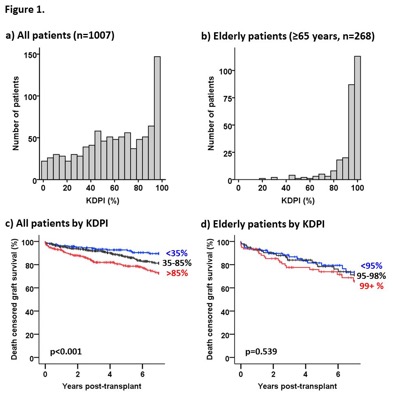The Use of Very High KDPI Kidneys in Elderly Kidney Transplant Recipients – Discarded in the U.S. but Successfully Transplanted in Europe.
Nephrology, Charité
Berlin, Berlin, Germany
Meeting: 2017 American Transplant Congress
Abstract number: 262
Keywords: Allocation, Elderly patients, Graft survival, Kidney transplantation
Session Information
Session Name: Concurrent Session: Long Term Kidney Graft Survival I
Session Type: Concurrent Session
Date: Monday, May 1, 2017
Session Time: 2:30pm-4:00pm
 Presentation Time: 2:42pm-2:54pm
Presentation Time: 2:42pm-2:54pm
Location: E450a
Background: Very limited data exist on long-term outcomes of very high KDPI kidneys in elderly (≥65 years) kidney transplant recipients (KTR). Discard rates of donor organs with a KDPI>95% were 72% in the US 2012-14.
Methods: This retrospective single center study included 1007 adult KTR who received a deceased donor kidney 1995-2015 and had complete recipient and donor characteristics at time of transplantation available. KDPI was calculated using the US OPTN data as reference.
Results: According to the characteristics of the Eurotransplant Senior Program elderly KTR received significantly older donor organs, spend less waiting time on dialysis, shorter cold-ischemic time and more HLA mismatches. The median KDPI in the study cohort was 67% (Fig.1a), while elderly KTR (n=268) mostly received organs with a very high KDPI (median 97%, Fig.1b). Categorization of all KTR by donor KDPI (<35%, 35-85%, >85%) confirmed significantly poorer survival of grafts with higher KDPI (p<0.001; Fig.1c).
However, the groups of elderly recipients with a very high donor KDPI of 95-98% (n=97, mean KDPI 96.7%) or even 99+% (n=78, mean KDPI 99.4%) showed no significant difference in terms of graft survival compared to elderly KTR with donor KDPI <95% (n=93, mean KDPI 81.4%) (p=0.539; Fig.1d). Even the category of KDPI 99+ kidneys showed satisfactory graft survival (73.9% after 5 years), while donors in this category had an unfavorable risk profile (mean donor age 76 years, 90% cerebrovascular death, 80% hypertension, 36% diabetes, mean donor cGFR 62 mL/min/1.73m2).
Mean death censored graft survival in elderly KTR was 10.1 years (CI 9.2-11.0), mean life expectancy 8.5 years (CI 7.7-9.4) indicating a good functional match between very high KDPI kidneys and elderly recipients in this cohort.
Conclusions: In Europe elderly KTR are frequently receiving high and even very high KDPI (99+) kidneys – mostly being discarded in the U.S. – nevertheless resulting in satisfactory graft survival rates. Efforts can be made to increase utilization of those donor organs for elderly kidney transplant candidates.
CITATION INFORMATION: Halleck F, Khadzhynov D, Rehse G, Lehner L, Schrezenmeier E, Dürr M, Budde K, Staeck O. The Use of Very High KDPI Kidneys in Elderly Kidney Transplant Recipients – Discarded in the U.S. but Successfully Transplanted in Europe. Am J Transplant. 2017;17 (suppl 3).
To cite this abstract in AMA style:
Halleck F, Khadzhynov D, Rehse G, Lehner L, Schrezenmeier E, Dürr M, Budde K, Staeck O. The Use of Very High KDPI Kidneys in Elderly Kidney Transplant Recipients – Discarded in the U.S. but Successfully Transplanted in Europe. [abstract]. Am J Transplant. 2017; 17 (suppl 3). https://atcmeetingabstracts.com/abstract/the-use-of-very-high-kdpi-kidneys-in-elderly-kidney-transplant-recipients-discarded-in-the-u-s-but-successfully-transplanted-in-europe/. Accessed December 21, 2025.« Back to 2017 American Transplant Congress

